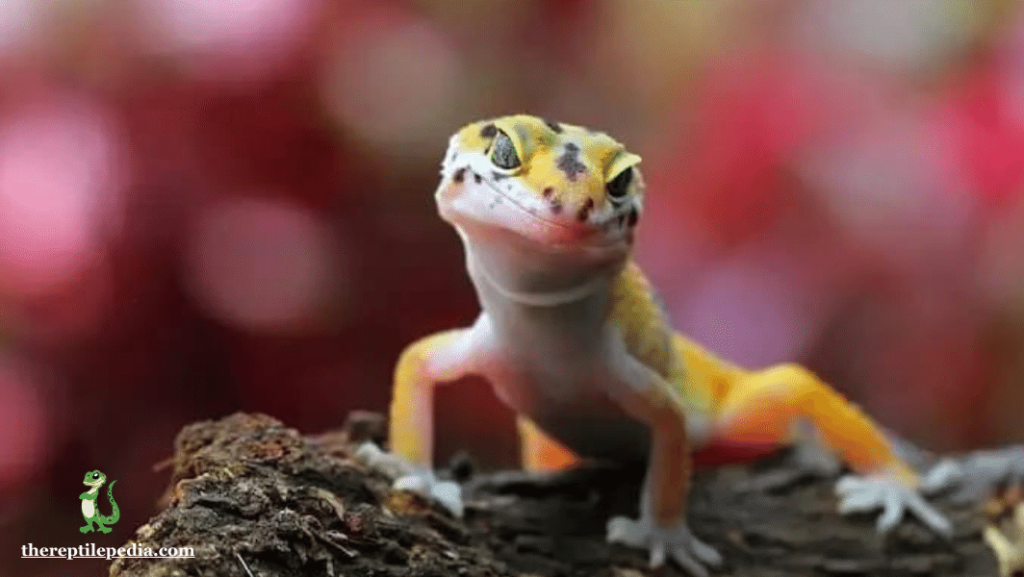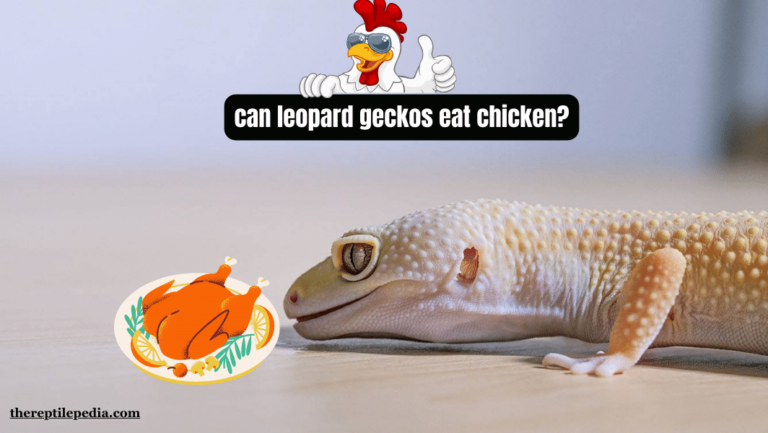As a reptile enthusiast, I’ve always been fascinated by the dietary habits of Leopard Geckos. These creatures, with their 100 sharp teeth, seem like they could handle a high-protein diet like chicken. However, it’s crucial to understand that despite their carnivorous appearance, Leopard Geckos are primarily insectivores. Their natural diet consists mainly of insects and invertebrates, making chicken a less-than-optimal dietary choice. It’s tempting to think that feeding your gecko chicken might be beneficial, but there are significant health risks involved.
Chicken, while nutritionally rich for humans, is not safe for these geckos due to its potential to be toxic and indigestible for their unique digestive systems. It’s advised to avoid offering any human foods, especially in situations that are not a rare emergency. Sticking to their natural food sources ensures your gecko remains healthy and avoids any unnecessary health complications.
Table of Contents
Chicken for Leopard Geckos ( Can eat or Not )
In the world of reptile care, the debate around whether to feed chicken to a gecko is nuanced. My personal insight suggests that offering chicken in one specific form, such as cooked chicken, might be acceptable on rare occasions. Although chicken is rich in an extensive amount of nutrients and proteins, it’s essential to align with the natural dietary preferences of these reptiles. Leopard Geckos, by nature, require a diet that helps them maintain a healthy life, focusing mainly on their instinctual consumption of insects.
Is Eating Chicken Good For Geckos?
While chicken may seem like a nutritious addition to a gecko’s diet due to its proteins, it’s not advisable to feed it to geckos on a regular basis. Instead, it could serve as an occasional treat, perhaps once a week, to add variety to their diet plans. However, the high fats in chicken are not good for a gecko’s health. The best way to incorporate chicken is in a small quantity of cooked chicken, carefully mixed into their regular meal of insects, ensuring they receive essential nutrients in a more healthful manner. This approach not only increases the dietary variety but also ensures the geckos get the required proteins for a healthy life without compromising their well-being.
Can Leopard Geckos Safely Eat Chicken?
While chicken is a rich source of nutrients, comprising about 80% protein and 20% fat, it’s not necessarily a safe dietary addition for your leopard gecko. Their stomach lacks a caecum to digest such a large amount of fat, making chicken, especially if fed on a regular basis, potentially dangerous. Feeding chicken more than occasionally can lead to serious illness or even death due to the inability of geckos to properly digest this type of food.
To minimize risks, any chicken offered should be in boiled form to ensure bacteria and parasites are eliminated. Raw chicken carries a risk of Salmonella bacteria, which, if swallowed, can cause significant illness in geckos. Even with these precautions, it’s crucial to consider the natural dietary needs of geckos and understand that chicken should not be a staple in their diet for their health and wellbeing.
Nutritional Benefits of Chicken for Leopard Geckos
- Balanced Nutritional Profile: Adding chicken in a small quantity to your leopard gecko’s diet provides a large number of proteins, essential for maintaining a healthy life. A 21-gram serving of boneless chicken wings contains about 6.4 grams of proteins and 1.7 grams of fat, offering a favorable protein-fat ratio that supports their overall health.
- Safe and Healthy: Incorporating chicken into their meals once in a week, particularly in a boiled form, is not harmful and can be considered part of the best diet practices for geckos, ensuring they receive vital nutrients without the risks associated with raw meats.
- Dietary Variety: Feeding a small amount of chicken, mixed with their regular diet of worms, insects, and crickets, introduces a welcome variety to their feeding regimen, keeping meal times interesting and engaging for your gecko.
- Cost-Effective and Accessible: Chicken is a low-priced, easily available food item on the market, making it a practical and economical addition to gecko diets, even in low quantity.
- Moderation is Key: The advantages of integrating chicken into your gecko’s diet are maximized when offered in moderation. Ensuring the amount and frequency are carefully regulated is crucial to maintain the delicate balance of their dietary needs and prevent any potential health issues.
- Expert and Personal Endorsement: Drawing from personal experience and expertise, I’ve observed that this approach not only enhances the nutritional value of their meals but also contributes positively to their overall well-being, affirming the practice’s efficacy when executed thoughtfully.
ALSO READ : Can leopard Geckos Eat Pinkies?
Why Chicken May Not Be Ideal for Your Gecko

A shortage of nutritional value
Delving into the dietary needs of Leopard Geckos, it becomes evident that chicken may not be the most suitable choice. While chicken, particularly a piece of breast chicken, boasts an 80% protein and 20% fat composition, this ratio starkly contrasts with what these reptiles require. In comparison to their natural prey, insects, which offer a more balanced 15% to 20% protein content and a healthier insect fat ratio of 2% to 8%, chicken is not nutritionally ideal. Even some cuts of chicken, known for their high protein and fat levels, can lead to an unbalanced diet and pose risks of future health complications due to too much protein and fat.
Despite the availability of insect treat options with protein levels around 17% to 22%, these are still substantially healthier and considered a staple food option for a gecko’s diet. Setting aside other chicken concerns, the feeding of chicken, even in small amounts, could result in nutritional imbalances, underscoring the importance of adhering to a diet that closely mimics their natural insect-based feeding habits for optimal health.
Safety
When contemplating the inclusion of chicken in Leopard Geckos’ diets, safety emerges as a paramount concern, overshadowing even the nutritional aspects. Feeding chicken, particularly raw or improperly processed meats, is a big no-no due to the inherent risks they pose. Raw chicken can harbor parasites and dangerous bacteria like Salmonella, a term referring to a family of bacteria that resides in the intestines of animals and remains invisible to the naked eye. These pathogens can be swallowed unknowingly and may infect geckos, with it being impossible to ascertain if a piece of chicken is a Salmonella carrier without a vet conducting cultures of the feces.
Moreover, Eating such contaminated food can cause not only diarrhea and stomach aches in geckos but, if transmitted, can lead to fever and more severe consequences in people. This makes the feeding of chicken not just a nutritional but also a biggest safety concern, necessitating a cautious approach. Setting aside other chicken concerns, the potential for such infections underscores why chicken, regardless of the cuts or insect treat options considered, is not a healthy staple food option for Leopard Geckos, leading to an unbalanced diet and risking future health complications.
Difficulty digesting
Leopard Geckos face significant challenges when attempting to digest meat like chicken due to their alkaline digestive tracts that lack the necessary acid to break down meat proteins effectively. Their skull and jaw structure, not evolved to cope with meat consumption, makes it harder for them to properly eat or even catch larger food items in their mouths. In the wild, they predominantly hunt smaller invertebrates, such as tiny bugs, which are best suited to their dietary needs and first choice in food. Given these physiological constraints, chicken is not an ideal option for their diet.
Challenges Posed by Leopard Geckos’ Dental Structure
The dental anatomy of Leopard Geckos reveals why chicken is not an ideal dietary choice for them. With around 100 teeth, and some geckos boasting even more, up to over 300 teeth, their tiny, sharp, conical-shaped teeth are designed for gripping, tearing, but not for grinding or munching on meat. These teeth are optimized to ensure no prey escapes, allowing geckos to swallow their prey whole. They primarily use their tongues to direct insects down their throat, a method of eating that is not appropriate for consuming items offered in an inappropriate size, such as chunks of chicken, which could lead to a risk of choke.
Feeding Chicken in Specific Circumstances
For a Leopard Gecko, chicken should only be fed in cases of emergency when all other options are exhausted, or for very rare occasions related to health-related reasons. If absolutely necessary, such as when force-fed through a syringe or when introducing new food options, ensure the chicken is thoroughly washed and cooked, then cut into small, pea-sized pieces to make it safer for swallowing and to avoid the risk of choking and associated impaction issues. Chicken baby puree might be used, considering the size and age of the gecko, ensuring the offering is gentle on their digestive system.
Crafting the Perfect Menu for Your Leopard Gecko
The diet of Leopard Geckos should be high in proteins and low in fat to keep them healthy and active. A balanced and varied diet, primarily consisting of insects, is essential to ensure they receive all the necessary nutrients. Embracing a 100% high-quality, live prey diet is ideal, effectively mimicking their natural diet in the wild, which is advantageous for their overall wellbeing. It’s crucial to assess the nutritional content before purchasing feed, opting for gut-loaded insects and supplementing with reptile calcium supplements to enhance their nutritional intake.
Live crickets, mealworms, silkworms, Superworms, Dubia roaches, and beetles are excellent options for the mainstay of their diet. Treats like waxworms, butterworms, and hornworms should be offered once a week due to their high-fat content; however, they can be given more often to younger or breeding geckos that have higher fat content needs. Maintaining this diet helps in avoiding overweight geckos and ensures Healthy Leopard Geckos thrive on a high protein diet with lower fat content. Despite being low-maintenance pets, geckos have unique dietary requirements that must be followed to keep them happy and thriving in captivity.
ALSO READ : Can Leopard Geckos Eat Stink Bugs?
Conclusion
While it’s technically possible to feed leopard geckos a very small quantity of chicken in a boiled form that is easily swallowed, it’s crucial to remember that this reptile is primarily an insectivore that thrives on a diet of insects. This article emphasizes that chicken should not become a part of their regular diet; giving it in a large quantity can lead to serious problems for your gecko’s health. Moreover, Don’t feed your gecko raw chicken, as it may contain harmful bacteria capable of causing serious illness. While chicken is not harmful when prepared and offered correctly, it should never overshadow the essentials of their natural dietary preferences.
FAQs:
-
Can leopard geckos eat meat?
Leopard geckos can eat meat in the form of small, live insects such as crickets, mealworms, and waxworms. It’s important to ensure the insects are appropriately sized, no larger than the space between the gecko’s eyes, to prevent choking. Feeding them live prey simulates natural hunting behavior, promoting physical activity and mental stimulation for the gecko.
-
Can I give my leopard gecko human food?
It is not recommended to give leopard geckos human food. Their diet should consist of live insects such as crickets, mealworms, and waxworms, which provide the necessary nutrients and promote natural hunting behaviors. Human food lacks the appropriate nutritional content for leopard geckos and can harm their health. Always ensure their diet is suitable for their specific dietary needs.

